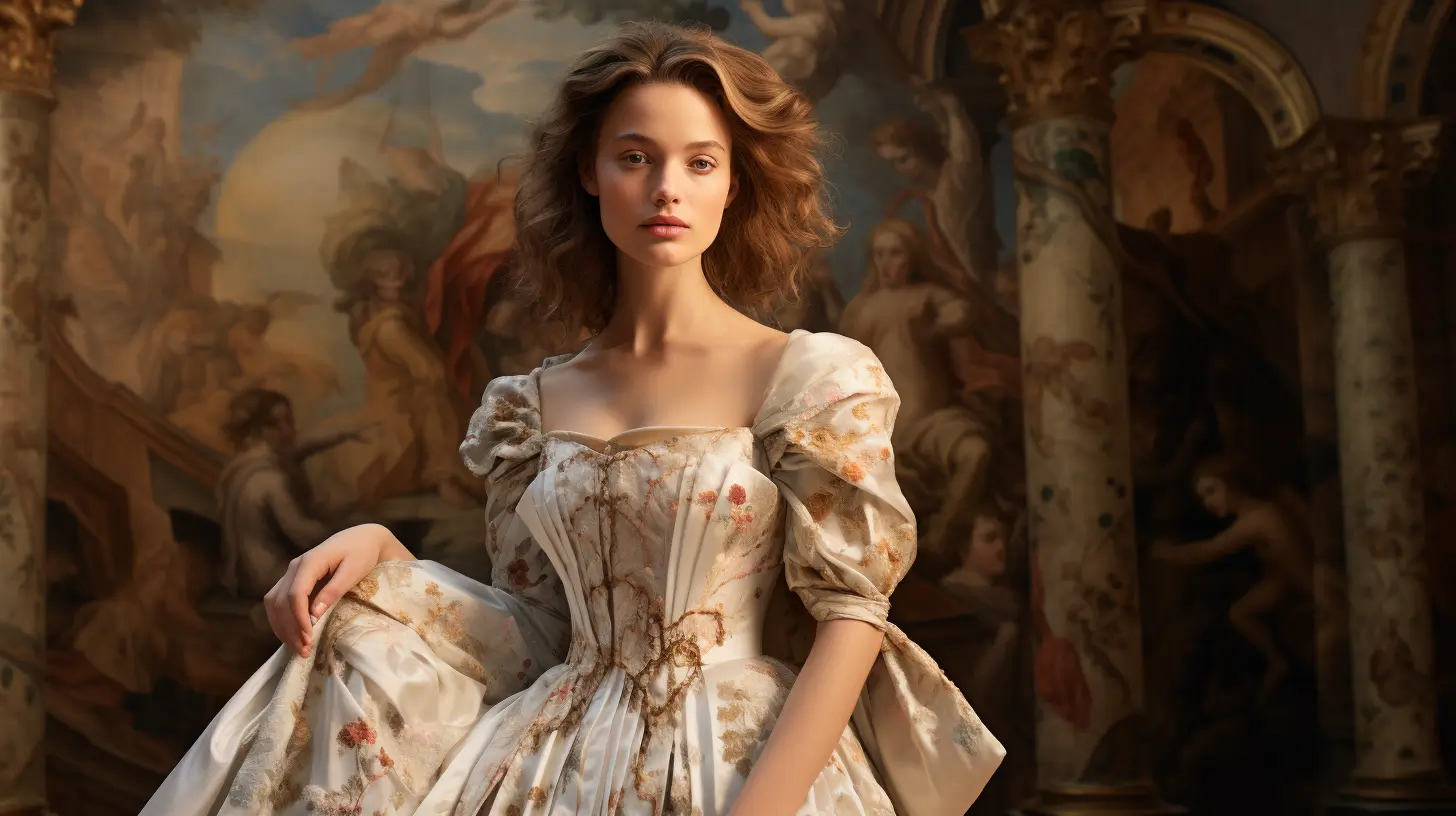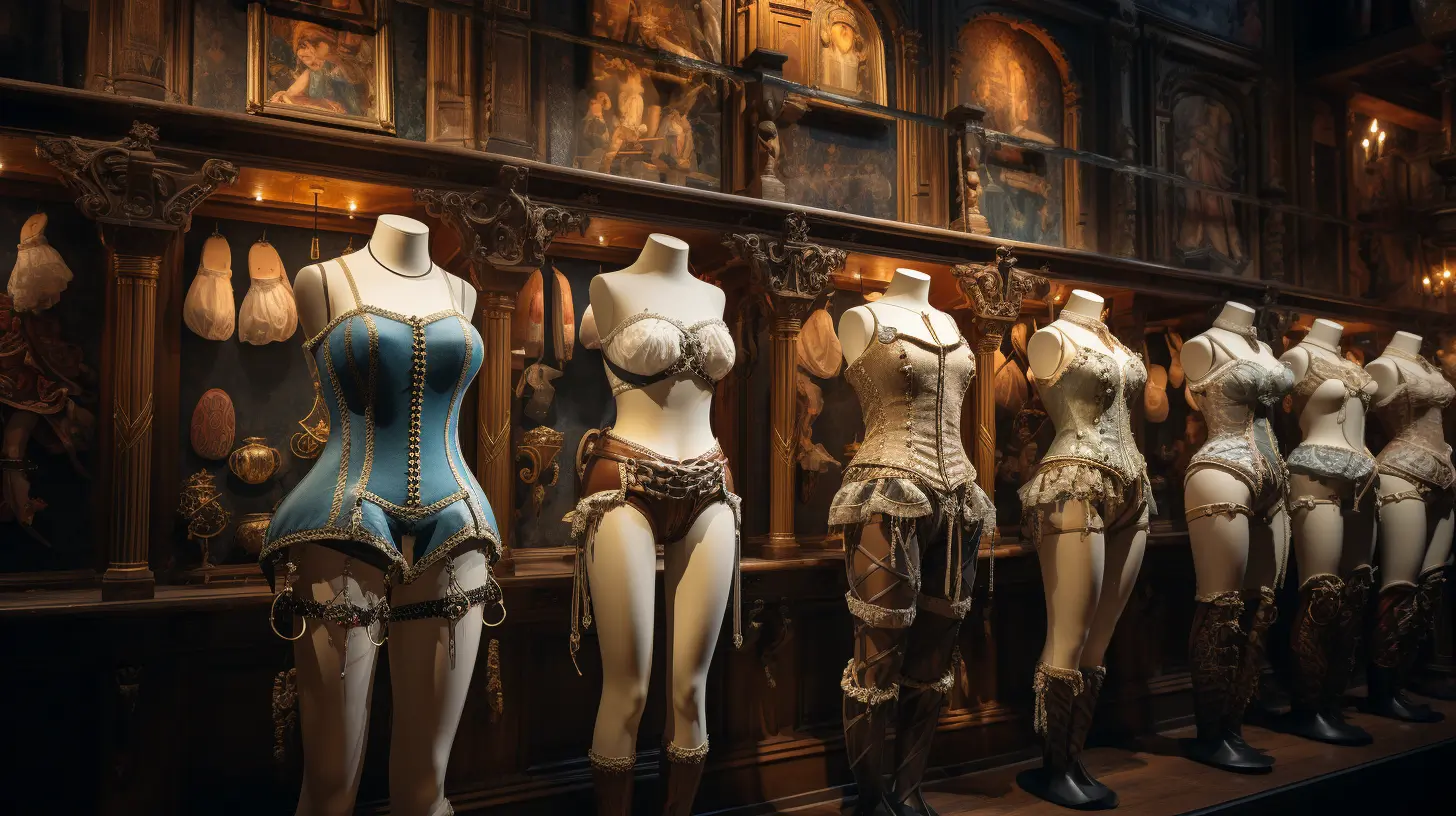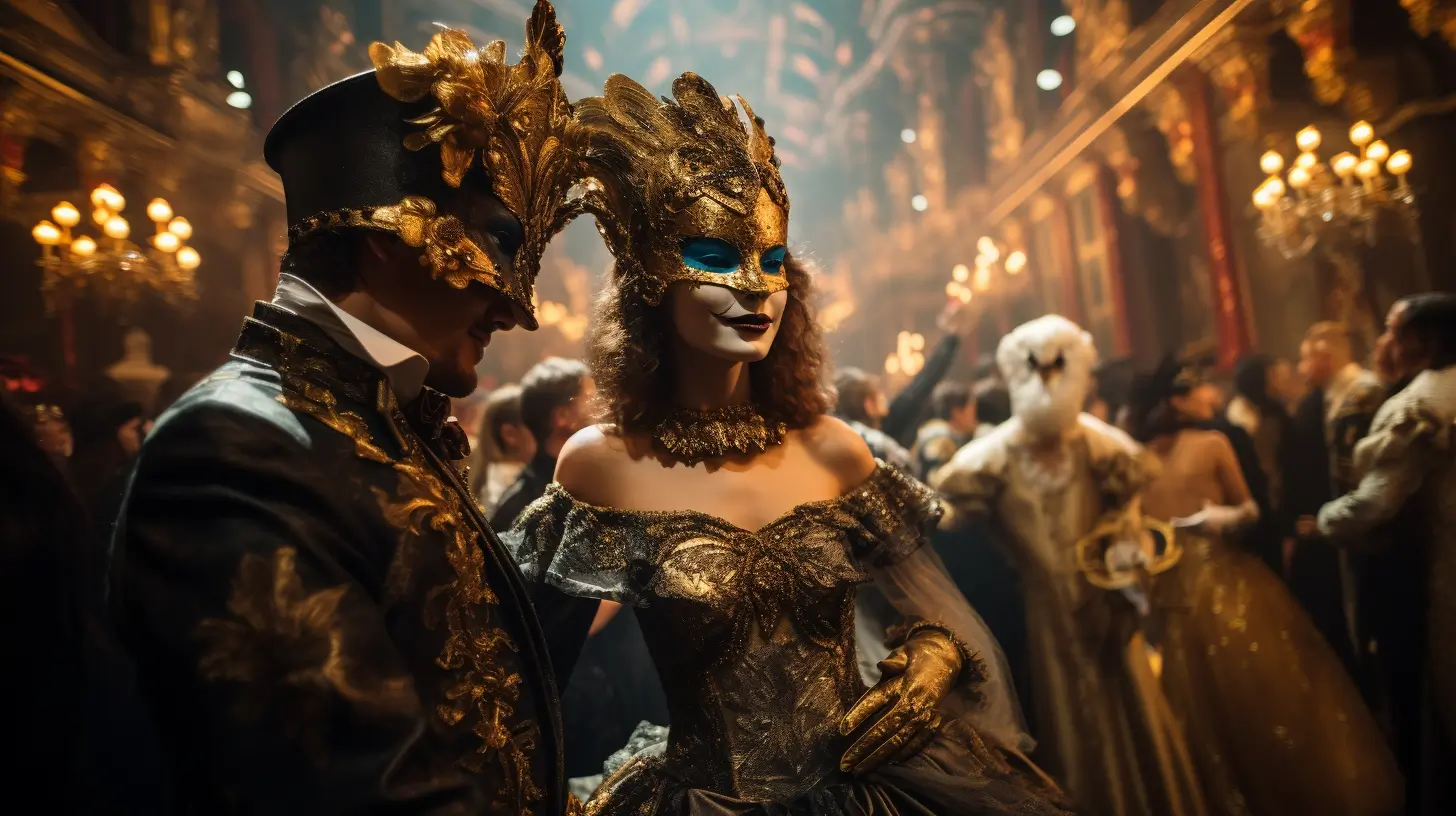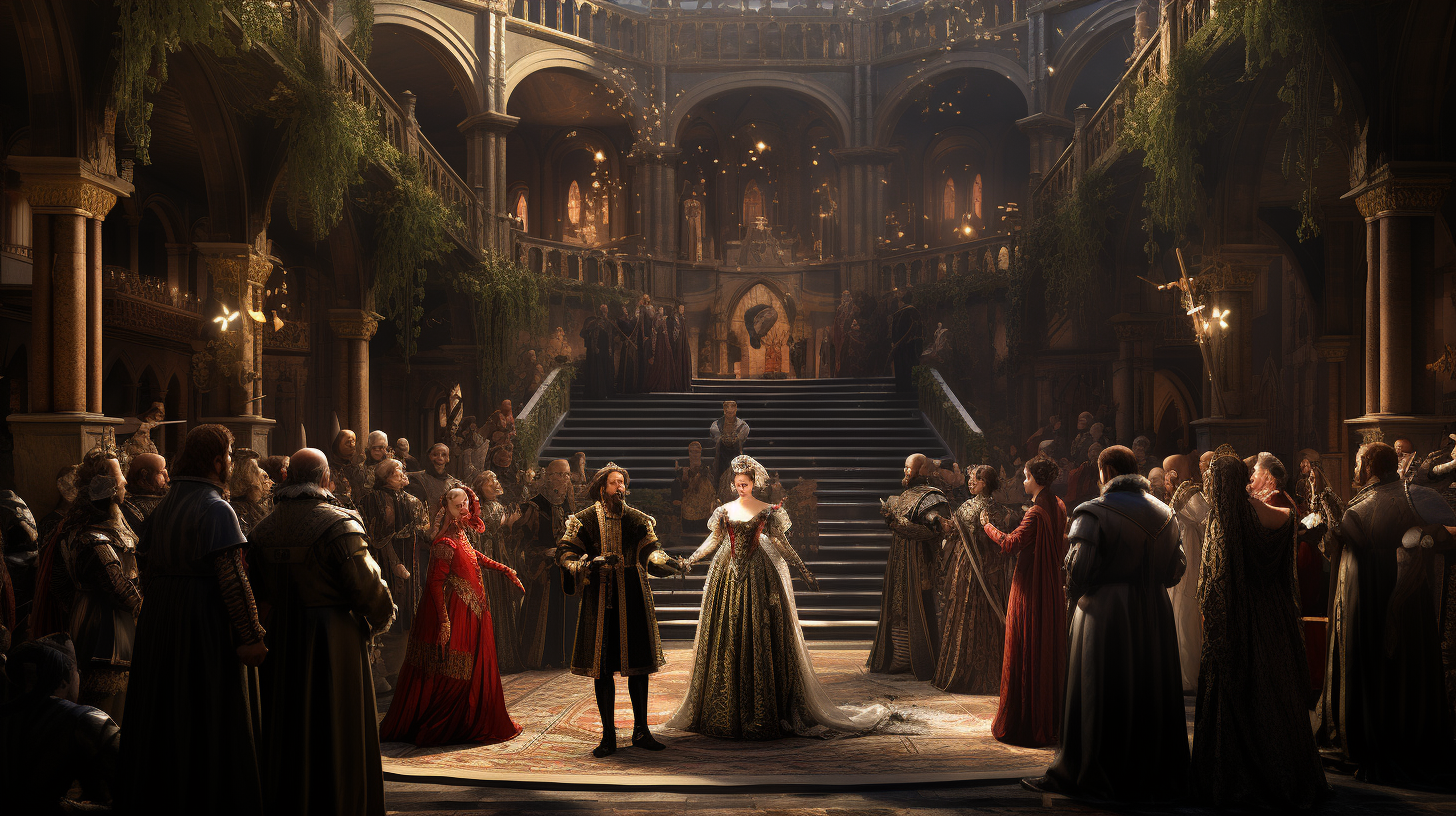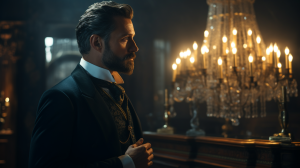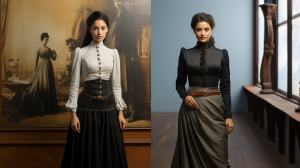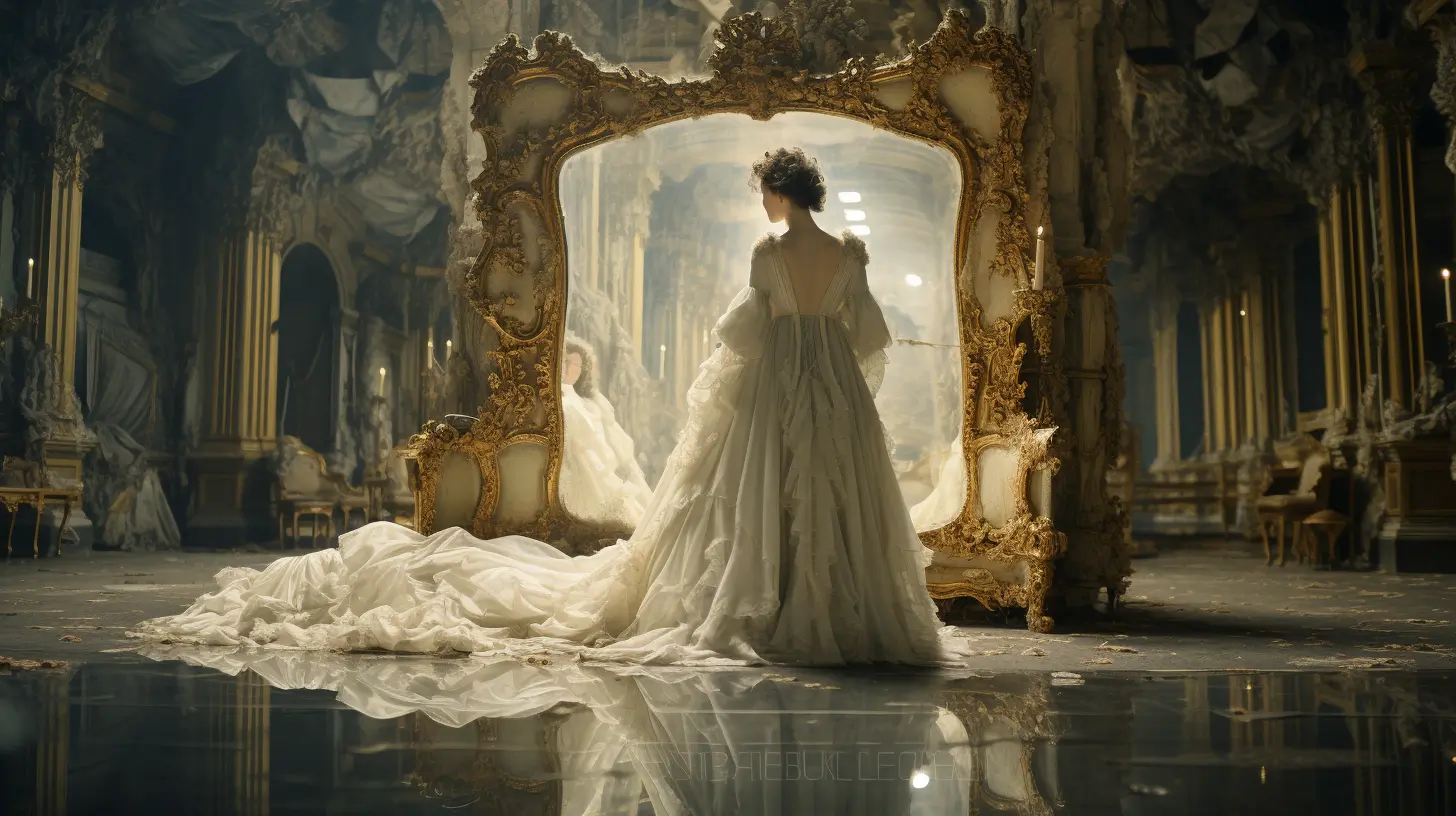
A Whimsical Journey Through Time: The Enchantment of Rococo Fashion
Ah, imagine stepping into an opulent chamber adorned with intricate gold filigree, where playful cherubs dance on murals above and crystal chandeliers sparkle like the night sky. Now, envisage yourself enveloped in layers of delicate silk and lace, painted in pastels as if kissed by the dawn itself. This is no mere daydream, my dear friends. We are venturing into the ethereal realm of Rococo fashion.
In the tapestry of history, each thread—each woven pattern—tells us a story of a specific time and place. Post-Baroque Europe was a canvas yearning for lightness, a touch of whimsy, and a dash of romanticism. As the heaviness of the Baroque era began to dissipate, a new fashion era unfurled its wings—Rococo. The term itself rolls off your tongue like a secret waiting to be revealed, much like the very fabrics and designs it represented. Originating in France and quickly spreading its influence across Europe, Rococo fashion was more than just clothing; it was an outward expression of the era’s innermost yearnings for beauty, extravagance, and delicate artistry.
🌸 A time where pastels reigned supreme, luscious fabrics were sculpted into cascading ruffles, and elegance was epitomized not just in grand salons but in every stitch and seam. This was a period where fashion became a form of escapism—a fantastical deviation from rigid societal norms. Yet, it was also a mirror, reflecting the nuances and shifts in society’s attitudes, its frivolity offering poignant contrasts to the somber shades of its predecessor, the Baroque era.
To truly understand the allure of Rococo fashion is to embrace its complexity—its defiance against the backdrop of political turmoil, its bold declaration of feminine aesthetics, and its immortal charm that beckons us to explore it centuries later. And so, as we traverse this captivating landscape together, keep an open mind and an eager heart. After all, fashion is not just fabric and thread; it’s a story waiting to be told.
Image Description: Envision a stunning oil painting that captures the essence of a Rococo salon. Men and women are elegantly dressed in period-appropriate attire, embodying the extravagance of the time. Their garments feature delicate laces, floral embroideries, and a sea of ruffles, all washed in a palette of soft pastels. Crystal chandeliers hang from the ceiling, scattering light across the room and enhancing the dreamlike atmosphere.
The Origins of Rococo Fashion: A Gentle Unfurling of Style
Behold, as we journey back in time to the France of the early 18th century. Here, the sun sets on the grandiosity of the Baroque era, making way for a new dawn—a dawn painted in hues of pastel and infused with a fresh breath of creativity. Rococo fashion was born out of this exquisite transition, and oh, how elegantly it found its footing.
🌿 The Sunset of the Baroque Era
The Baroque period was a theatrical spectacle, heavy both in its ornate aesthetics and the fabrics that dressed the nobility. Structured gowns with tight corsets were the order of the day, as were sumptuous silks and velvets, often in darker colors. Yet, as is the nature of art and life, change was inevitable. There was a palpable yearning for something lighter, more carefree. And as the Baroque sun dipped below the horizon, the Rococo era began to take form, sprouting like a delicate bud after a long, hard winter.
🌸 The Birth of a New Aesthetic
Let your mind drift to an 18th-century French salon where pastel shades of pink, blue, and lavender fill the room. Women began to discard cumbersome gowns for dresses with lighter fabrics like taffeta and fine linen. Intricate floral motifs, scalloped edges, and delicate lace were the new vogue. It was a celebration of life, an unspoken declaration that the weight of the past could be, if not forgotten, at least made more beautiful.
🎭 The Influence of Court Life
Versailles was not just a royal residence; it was the beating heart of fashion and culture. It was here that the Rococo style found its most passionate advocates. The court of Louis XV, and especially his chief mistress Madame de Pompadour, played pivotal roles in popularizing this new fashion ethos. Imagine intricate gowns and suits, adorned with detailed embroidery and lace, as though fairies themselves had a hand in their creation. It was fashion conceived not for utility but for the sheer joy of existence, a reflection of the era’s optimistic spirit.
🎨 The Role of Art and Artists
Art and fashion have always been close companions, and in the Rococo era, this relationship was exceptionally symbiotic. Artists like François Boucher and Jean-Honoré Fragonard captured the whimsy and lightness of Rococo in their paintings, often illustrating contemporary fashions. These artworks were a vivid tableau of the era’s aesthetics, as artists and tailors often inspired one another.
Image Description: Picture an 18th-century French salon filled with elegantly dressed men and women, their attire encapsulating the very essence of Rococo fashion. Soft hues of pastel color the room, and natural light seeping through large windows seems to dance on the delicate fabrics. The walls are adorned with paintings that perfectly encapsulate the fashion and sensibilities of the time.
The Quintessential Elements of Rococo Garments: A Tapestry Woven with Threads of Whimsy 🎀
In the lush panorama of fashion history, the Rococo era paints an intimate portrait. It’s as if the canvas of fabric was touched by the brushstrokes of artists, lovers, and dreamers alike. You may wonder, what were the elements that conjured this spell? How did garments articulate the unspoken feelings of an era craving beauty and lightness? Allow me to guide you through the intricate web of this sartorial masterpiece.
🎨 The Pastel Palette
In the Rococo age, color spoke in soft whispers. Gone were the bold, regal shades of the Baroque era, replaced instead by pastels that mimicked the earliest light of dawn—rose pinks, sky blues, and delicate lilacs. These colors were like sonnets written in fabric, gentle and romantic, creating an atmosphere of youthful innocence.
🍃 Fabrics that Breathed
One could say that the fabrics of the Rococo era were like a gentle breeze on a warm day—refreshing, light, and utterly inviting. Materials such as muslin, linen, and fine silks took center stage, allowing the wearers a newfound freedom of movement. Gone were the heavy velvets and stiff brocades; the Rococo spirit lived in the flutter of a skirt and the fluid grace of a well-tailored coat.
🌹 Cascading Ruffles and Lace
In this era, ornamentation found its muse in nature. Picture layers of soft ruffles mimicking the petals of a blooming rose, or lace as intricate as a spider’s web glistening in the morning dew. These details were not mere additions but the essence of Rococo fashion, each stitch a verse in a love poem to beauty.
🦋 The Emblem of the Bow
If one motif could encapsulate the Rococo ethos, it would be the bow. Ever-present, the bow was the cherry on top, the finishing touch. Whether accenting a lady’s waist or a gentleman’s cravat, it was a playful nod to the era’s obsession with ornamentation, a small but eloquent declaration of one’s adherence to the Rococo ideal.
Image Description: Imagine a Rococo-era woman, clad in a gown of the softest rose-pink, standing before an antique mirror. The dress features cascading ruffles, delicate lace, and is cinched at the waist with a bow. The image captures the very quintessence of Rococo fashion elements, set against a backdrop that mirrors the era’s aesthetic.
The Role of Women in Rococo Fashion: Champions of Aesthetic Freedom 🌷
Sometimes we find a chapter in history where the ink of influence is bold and beautifully feminine. The Rococo era was such a time, an age where women were not merely the canvas but also the artists shaping the fashion tapestry. Let’s unpack this untold but critical aspect of Rococo fashion.
👒 The Tastemakers
Long before the dawn of social media influencers, women in the Rococo era were the arbiters of style. Through salons and courtly gatherings, they dictated the trends that would permeate society. The exquisite taste of these women didn’t just influence their inner circle; their style choices reverberated throughout Europe, impacting even the textile industry.
💌 The Freedom to Choose
Choice—a simple yet potent word. Women of this period enjoyed a sense of agency over their clothing that was unprecedented. They could opt for lighter fabrics, experiment with varied hues, and even influence the designs themselves. This level of sartorial freedom became a mode of self-expression and was vital in solidifying the core aspects of Rococo fashion.
💎 The Era’s Icons
No story is complete without its protagonists. Women like Madame de Pompadour and Marie Antoinette became synonymous with the extravagance and idealism of the era. They were the living embodiments of Rococo philosophy, pushing the boundaries of fashion to incredible heights of creativity.
🎭 Fashion as Social Commentary
Clothes were more than threads and needles; they were a medium of nuanced societal discussions. Issues such as gender roles, freedom, and beauty standards were dialogues woven into the fabric of Rococo attire. By choosing to dress a certain way, women could subtly express their perspectives on these matters, contributing to a fascinating tapestry of ideas and beliefs.
Image Description: Envision a Rococo salon filled with elegantly dressed women. In the center stands a figure—perhaps Madame de Pompadour herself—donning a captivating gown adorned with ribbons and lace. Her style is the focal point of admiration and discussion, perfectly capturing the pivotal role women played in shaping the fashion narrative of the era.
The Gentleman’s Guide to Rococo Attire: Defining Chivalry Through Threads 🎩
While the women of the era were veritable muses of Rococo style, let’s not forget the men who walked beside them—equally resplendent in their lavish attire. For gentlemen, clothing wasn’t just about aesthetics; it was a representation of their character, a sartorial code of conduct.
👔 The Quintessential Elements
It’s crucial to understand the components that made up a gentleman’s wardrobe. From the intricately designed justaucorps to the embroidered waistcoats, every article had its place and purpose. The tricorn hat was the cherry on top, adding a flair of sophistication. Footwear, too, was a matter of artistry—silk stockings and bejeweled buckled shoes were the norm, not the exception.
🎨 The Palette of Prestige
Color played an instrumental role in conveying not just style but status. While the women flirted with an array of shades, the men predominantly adorned darker hues—navy, bottle green, and rich burgundy. These shades oozed power and commanded respect, all the while allowing their personalities to shimmer through the fabric.
⚔️ Subtle Militaristic Influences
Intriguingly, military aesthetics infiltrated the garments of Rococo gentlemen. Epualettes, gold braid, and regimental buttons all found their way onto civilian coats. These details were not merely decorative; they were a nod to the martial spirit of the age, subtly blending the worlds of fashion and function.
🌹 Etiquette Expressed in Ensemble
Clothing was a language, and a well-dressed man spoke volumes without uttering a word. Whether attending an opulent ball or a more subdued gathering, the attire was thoughtfully chosen to suit the occasion. This attention to detail elevated the social grace of Rococo men, rendering them not just well-dressed but well-mannered.
Image Description: Picture a Rococo gentleman, perhaps in the company of Madame de Pompadour. He is dressed in a lavish, dark-hued justaucorps, adorned with subtle gold embellishments. His tricorn hat rests elegantly on a nearby table, drawing attention to his embroidered waistcoat. The image captures the epitome of masculine elegance in the Rococo era.
The Artistry Behind Rococo Fabrics and Textures: A Symphony of Silk and Satin 🎨🧵
In the journey of unravelling Rococo attire, we’ve crossed the landscape of styles and palettes. Now, let us dwell into the very soul of the fashion—the fabric. The choice of materials is akin to selecting the ink for a pen that will write history. After all, when it comes to Rococo fashion, the devil truly is in the details.
💎 Silk: The Pinnacle of Luxury
The ruling monarch among fabrics in this era was undoubtedly silk. Whether it was brocaded, damask, or a simpler taffeta, silk was the canvas upon which Rococo artisans painted their dreams. Light and malleable, yet exuding sheer opulence, silk was an immediate status symbol. Even today, a Rococo-inspired silk garment speaks the language of luxury without the need for translation.
🌸 Embroidery: Crafting the Narrative
Embroidery was not merely a decoration; it was a storytelling technique. With each stitch, symbols and motifs were carefully woven into the fabric, each with its own distinct meaning. The level of complexity in Rococo embroidery is awe-inspiring, featuring not just floral designs, but often mythological scenes or intricate geometries.
🎭 The Drama of Lace and Ruffles
While silk and embroidery were central, let’s not ignore the drama added by lace and ruffles. These embellishments created a sense of movement, almost as if the garments were imbued with a life of their own. Lace collars, ruffled sleeves, and layered hems weren’t just ornamental; they were the equivalent of a theatrical crescendo in a Mozart symphony.
🌿 Natural Dyes: The Unsung Heroes
The brilliance of Rococo colors owed much to natural dyes. Ingredients like indigo, madder root, and even certain insects were used to create hues that still bewitch us today. This was not merely a matter of aesthetics; it was an embrace of the natural world, fusing it with human artistry.
Image Description: Envision a still life featuring luxurious Rococo fabrics—rolls of opulent silk, reels of gold thread for embroidery, and swatches of intricate lace, all neatly arranged on an antique wooden table, bathed in the soft glow of a candlelight. The image encapsulates the richness and tactile experience of Rococo textile artistry.
Rococo Accessories: Adorning the Adorned 🎭💎
As we traverse this luxurious world of Rococo, we arrive at the gallery of accessories. Because, my dear friends, even beauty can be beautified. Accessories are not mere complements; they are individual statements, a language of their own.
🎩 Hats and Headgear: A Crown for Every Head
The Rococo era was a festival for milliners. The tricorne hats for men were often embellished with feathers, gemstones, and even miniature landscapes. For women, the “pouf” was nothing short of an architectural marvel. Sometimes rising over a foot high, it was a scaffold of ribbons, lace, and ornaments. When you donned a hat in the Rococo period, you weren’t just covering your head—you were exhibiting art.
📿 Jewelry: The Galaxy on Your Skin
Ah, the realm of jewelry—a visual symphony of gold, silver, and precious stones. Necklaces cascaded down necklines like waterfalls of diamonds. Brooches were not mere pins; they were miniature portraits or intricate botanical scenes captured in a frame of gemstones. Jewelry in this era was not just decorative, it was deeply symbolic, often serving as tokens of love, allegiance, or mourning.
🎀 Ribbons and Sashes: The Soul’s Melody
Ribbons and sashes were not merely fabrics but the very melodies of the soul translated into silk and satin. These winding bands of textile were often embroidered with messages or monograms, a practice akin to sending a handwritten note today. Draped around waists, tied into bows, or fashioned into rosettes, they brought personality to the already grand ensembles.
👛 Pouches and Reticules: Small Universes of Beauty
These were not just mere containers. They were the keepers of secrets, carriers of fragrances, and miniature treasure chests. Often made from the finest of fabrics and decorated with embroidery or small painted scenes, these pouches and reticules were the predecessor to today’s designer handbags.
Image Description: Imagine a vintage vanity table adorned with Rococo accessories. A towering feathered hat, intricately crafted brooch, lavish ribbons, and a delicate silk reticule rest on the table, each bathed in the warm, ethereal light of a golden candelabra. The tableau evokes an intimate, romantic atmosphere, capturing the personal relationship between Rococo fashion and its wearers.
Rococo Footwear: From Heel to Toe 👠🌹
Oh, yes. You see, beauty in the Rococo era was not a concept limited to above the ankles. The pièce de résistance sometimes rested in the intricate designs of footwear, adding not just steps but statements to the grand floors of Versailles and beyond.
👞 Men’s Footwear: The Sultans of Swag
Men’s shoes in the Rococo era were not just foot coverings but foot thrones. Ornate buckles often adorned these leather treasures, made from the finest materials that money could procure. Embroidery was not uncommon, often featuring floral patterns or even family crests. A buckle was not just a fastening device; it was a symbol of wealth and standing. With every step, the men of the Rococo era left an imprint of their status.
👠 Women’s Footwear: A Garden for Your Feet
Ladies, prepare to be swept off your feet—literally. Women’s shoes during this time were like miniature gardens. The use of silk, satin, and lace was pervasive. Delicate ribbons would be tied in perfect bows, often harmonizing with the colors of the gown worn. Heels were chunky and curved, often adorned with ornate carvings resembling the twirls of a Baroque painting. When a lady stepped into a room, it was as if a floral bouquet had come to life.
🤔 The Importance of Footwear in Social Settings
Shoes spoke volumes in social settings. A nobleman or woman’s shoes could either elevate them to new heights or send them stumbling down the social ladder. Footwear was a clear signifier of one’s status, education, and even personal taste. In a world obsessed with exterior beauty, shoes were, quite literally, the foundational element of one’s attire.
🚀 Revolutionary Designs
Some Rococo shoes were so avant-garde that they would be considered revolutionary even by today’s standards. Detachable heels? They thought of it first. Built-in pockets inside boots to store valuables? Ah, the innovation!
Image Description: Picture a lavish Rococo ballroom filled with elegantly dressed people. Zoom into the feet of a man and a woman, where the spotlight rests. His shoe bears a gleaming buckle that seems to be crafted from gold and diamonds. Her shoe is a vibrant medley of silk and satin, resembling a blooming garden. Their feet are works of art, signifying the importance of footwear in Rococo fashion.
Textiles and Fabrics: The Threads of Elegance 🎨🧵
Let us proceed, then, to the very material that gave form to the masterpieces we so admire. In the realm of Rococo, the choice of fabric was no trivial matter; it was a declaration of taste, wealth, and sometimes even political stance.
🌸 Silk: The Queen of Fabrics
Ah, silk. This lustrous, luxurious fabric reigned supreme. Originating from the silkworm, this textile was the epitome of opulence. Often reserved for the wealthiest members of society, silk garments were meticulously crafted. The sheen of a silk gown under the chandeliers was a spectacle in itself. The fabric could be dyed in vivid hues, making it the perfect canvas for the Rococo’s extravagant patterns and embellishments.
🍂 Linen and Cotton: The Everyday Elegance
While silk was for special occasions, linen and cotton found their place in everyday attire. More breathable and easier to maintain, these fabrics had a quieter, more subdued elegance. Cotton, in particular, was a newer introduction during this period, arriving from colonial lands. Its durability made it popular for undergarments and even some day-wear. Linen, on the other hand, was the workhorse of the Rococo textile industry—reliable, sturdy, yet always in style.
🎭 Velvet and Brocade: The Drama Kings
Velvet and brocade were the dramatic divas of the textile world. Velvet, with its plush, deep texture, was often reserved for evening wear or ceremonial garments. Brocade was similar but had patterns woven into the fabric itself, often in gold or silver thread. Imagine the marriage of intricate design with lavish material—a true match made in Rococo heaven.
🎨 Dyes and Patterns: A Symphony of Color
The Rococo era was a riot of color and patterns. Whether it was natural dyes derived from plants and animals or newer, synthetic ones, there was no shortage of options. Patterns were elaborate, frequently featuring florals, landscapes, and even entire scenes from mythology. The world was a canvas, and these fabrics were the brushstrokes that made it come alive.
Image Description: Envision a table laden with various Rococo fabrics—each one more opulent than the last. There’s silk with a sheen that catches the light, linen that looks soft and breathable, velvet that begs to be touched, and brocade that shimmers with intricate gold designs. Each fabric is laid out in such a way that it catches the eye and beckons the fingers to feel its unique texture.
Accessories: The Finishing Touches 🌟💍
Let us, my friends, turn our gaze to the pieces that complete the ensemble. Accessories in the Rococo era were not merely afterthoughts. Oh no. They were the cherries atop a magnificent, opulent sundae.
📿 Jewelry: A Gem of an Addition
Jewelry was akin to punctuation in a sentence; it may appear small, but it plays a significant role. Necklaces often featured precious stones like diamonds, rubies, and emeralds, set in intricate patterns that mimicked the ornate designs of the garments themselves. Earrings, meanwhile, were usually chandelier-styled, long and delicate, designed to frame the face like a masterpiece. Brooches and cameos, often depicting scenes from mythology or portraiture, were pinned to gowns and coats, adding layers of meaning to one’s attire.
👒 Hats and Headgear: The Crowning Glory
Headgear in Rococo fashion ranged from towering wigs for men to intricate bonnets for women. Women’s bonnets were often made of silk or satin and adorned with lace, ribbons, and sometimes fresh flowers. Men’s wigs were powdered and might even include a small tricorn hat perched atop. Indeed, a person’s head was a canvas, and the headgear was the art.
🎭 Masks and Fans: The Instruments of Mystery and Grace
Masks were an essential part of the masquerade balls that were all the rage. Usually crafted from velvet or silk and bedecked with gems and feathers, they were as much about artistry as anonymity. Fans were not just functional but ornamental. Often made from fine lace or silk, they were sometimes painted with scenes or motifs that reflected the owner’s interests or the themes of an event.
👛 Purses and Snuff Boxes: Little Wonders
Though small, items like purses and snuff boxes held great importance. Purses were tiny, often just large enough to hold a few coins and a handkerchief, but they were crafted with the same care and attention to detail as any gown or coat. Snuff boxes, usually for men, were often made of gold or silver and were yet another canvas for artistry, featuring miniature paintings or intricate engravings.
Image Description: Visualize a still-life tableau featuring an array of Rococo accessories. There’s an intricate bonnet made of silk, a golden necklace encrusted with emeralds, a velvet mask adorned with peacock feathers, a finely painted fan, and a delicate snuff box with an engraved lid. Each item radiates its own aura of elegance, yet together they form a symphony of style.
The Grand Tapestry: Weaving Together the Threads of Rococo Fashion 🎭🌹✨
And so, we arrive at the moment where we reflect upon the elaborate labyrinth that is Rococo fashion. It’s a moment of quiet, much like the final note in a concerto, a note that doesn’t just mark an end but also encapsulates the entire journey. Shall we delve into this retrospective?
A Renaissance of Artistry 🎨
This era wasn’t just about clothing; it was about creating art that one could wear. From the intricate lacework on the gowns to the minuscule engravings on snuff boxes, Rococo was an era that embraced craftsmanship with a passion that bordered on reverence.
A Tale of Two Genders 👫
Men and women were equal players on this sartorial stage. Both sexes wore intricate, layered ensembles that were the epitome of opulence. Though different in silhouette and components, the clothes for men and women were unified by the common theme of extravagant elegance.
The Language of Fashion 🗨️👗
Rococo fashion was not just fabric and thread; it was a language. Every choice, from the hue of a garment to the jewels adorning a necklace, was a word in a sophisticated vocabulary of style. It communicated rank, interests, and even political affiliations, allowing individuals to express their identity in a world teeming with societal norms and regulations.
Beyond the Surface 🌠
Yes, it’s easy to look at the Rococo era as a period of superficial beauty. But, dig a little deeper, and you’ll discover a world that mirrored the social and cultural nuances of the time. The opulence was a response to a society that yearned for escapism, the complexity a reflection of an age that was grappling with rapid changes in politics, art, and philosophy.
Image Description: Imagine a painting that brings all these elements together—two figures, a man and a woman, attired in the finest Rococo fashion, standing amidst a backdrop of a luxurious drawing room. Their outfits are not just clothes but narrators, each element telling a part of their story. The viewer can almost hear the murmur of a harpsichord and the chatter of a society soiree filling the air. It’s not just a picture; it’s an entire world caught in a single frame.
The Last Stitch: A Reverie on the Elegance and Intricacy of Rococo Fashion 🌌✂️🌹
Well, my friends, we’ve reached the end of this lavish, opulent journey through the Rococo era. You could argue that it’s all superficial, a spectacle of vanity and excess. But it’s in the tiny details, the underlying motifs, that we really come to appreciate the depth of this era. So, let’s pull back and soak in the grand mosaic we’ve pieced together.
The Craftsmanship That Speaks Volumes 🎨
We began with a deep dive into the artistry that graced every article of clothing, every accessory. In a time when artisans were akin to rock stars, their virtuosity found a stage in every ballroom, every salon. It’s a little like tasting a dish where every ingredient has been meticulously chosen; nothing is accidental.
Gender Fluidity in a Rigid Society 👫
We examined the sartorial choices of both men and women, an embodiment of personal freedom in a society bounded by norms. Kind of like a gourmet burger in a fine-dining restaurant—unexpected yet perfectly in tune with the surroundings.
Words and Stitches 🗨️👗
We touched upon the semiotics of fashion in this era. Beyond just fabric, we’re talking about a complex dialogue. The same way that a carefully crafted menu tells you about a chef’s training, his palate, his journeys, and even his bouts with heartbreak, each garment was an autobiography.
Culture Wrapped in Silk and Lace 🌠
Then, we delved beyond the surface, unearthing the era’s connections with the zeitgeist of its day. It was the sushi of the 18th century—simple on the outside, complex within, and reflecting a world in flux.
Image Placeholder: Let’s encapsulate this finale with an artwork. Picture an ornate Rococo frame, the kind that would make even the stuffiest of aristocrats blush. Within it, a mirror reflects the viewer, dressed in contemporary clothes, contrasting yet somehow blending into a grand Rococo ballroom behind them. It asks the question: How different are we, really?
So there you have it. It’s easy to get lost in the corsets and cravats, but remember, every stitch has a story, every color a meaning, every layer an echo of the times and the people who lived them. It’s a vivid tableau, a microcosm of humanity during one of its most paradoxically constrained and yet extravagant epochs.


